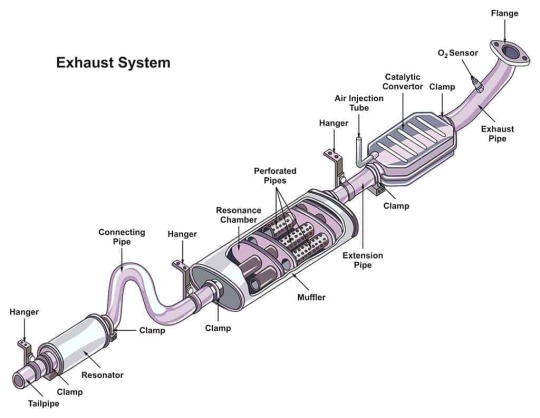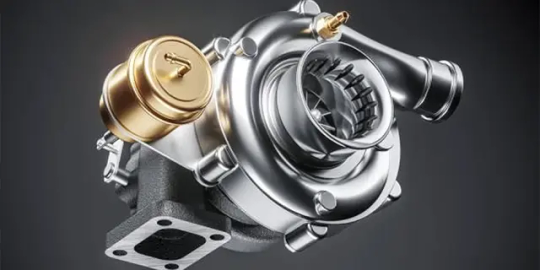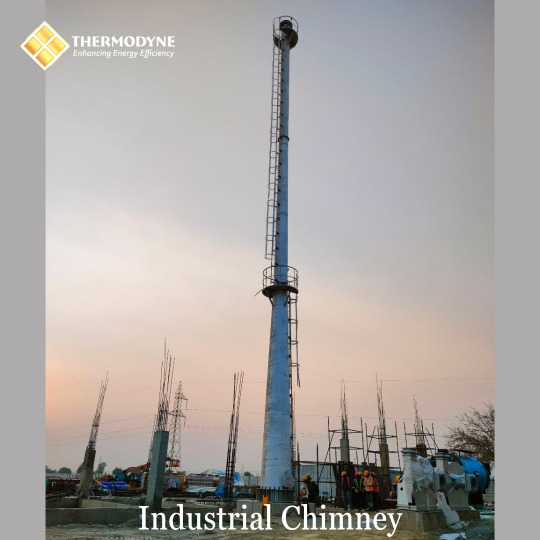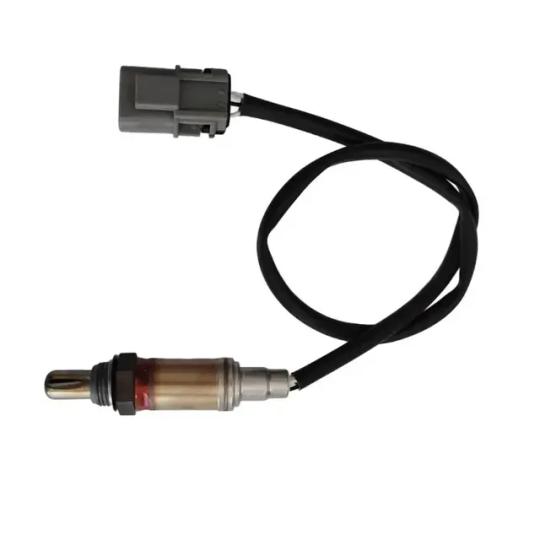#EmissionControl
Explore tagged Tumblr posts
Text
Exhaust System Market Outlook 2025–2030: Trends, Growth, and Forecast

The exhaust system market is undergoing a transformative phase, driven by stringent emission regulations, the evolving landscape of internal combustion engines (ICEs), and the growing integration of hybrid technologies. With the automotive industry straddling the line between traditional fuel-based engines and full electrification, exhaust systems remain critical for performance, efficiency, and compliance.
As the global focus shifts toward cleaner transportation, the 2025–2030 outlook for the exhaust system market suggests a mixture of innovation, disruption, and sustained relevance in niche and hybrid segments.
2. Market Overview and Definition
An automotive exhaust system is designed to direct and treat the exhaust gases emitted from an internal combustion engine. These systems minimize pollutants, reduce noise, and enhance fuel efficiency and engine performance. Key components include the exhaust manifold, catalytic converter, muffler, resonator, diesel particulate filter (DPF), and tailpipe.
Despite the rise of electric vehicles (EVs), which lack traditional exhaust systems, demand remains robust due to the continued dominance of ICE and hybrid vehicles—particularly in developing economies.
Click here to download the sample report
3. Market Dynamics
3.1 Key Drivers
a. Stringent Emission Regulations
One of the primary market drivers is the global effort to reduce greenhouse gas (GHG) emissions. Regulatory bodies like:
Euro 6/7 (Europe)
CAFÉ Norms (U.S.)
BS-VI (India)
China 6 Emission Standard
…have prompted automakers to upgrade their exhaust systems, integrating advanced technologies like Selective Catalytic Reduction (SCR) and Diesel Oxidation Catalysts (DOCs).
b. Growing Commercial Vehicle Segment
Heavy-duty vehicles (HDVs) and light commercial vehicles (LCVs) require complex exhaust systems due to their larger engines and longer operational hours. With increased global trade and urbanization, demand in this segment is surging.
c. Rise of Hybrid Vehicles
Hybrid vehicles, which combine ICEs and electric powertrains, still require efficient exhaust systems. With hybrid adoption expected to remain strong through 2030, the segment is a major market propeller.
3.2 Restraints and Challenges
a. Electric Vehicle Penetration
EVs are inherently free of combustion-related emissions, eliminating the need for exhaust systems. As EVs gain market share—particularly in developed regions—traditional exhaust component demand will taper off in the long term.
b. Raw Material Volatility
Fluctuating prices of materials like stainless steel, aluminum, and precious metals (used in catalytic converters) impact manufacturing costs and profit margins.
3.3 Opportunities
a. Aftermarket Growth
The replacement of exhaust system parts due to wear, corrosion, and compliance upgrades represents a lucrative aftermarket opportunity.
b. Innovation in Lightweight Materials
OEMs are investing in titanium alloys and composites to reduce vehicle weight, improve fuel economy, and maintain structural integrity under high temperatures.
c. Smart Exhaust Systems
Digital exhaust systems with sensors for real-time emissions monitoring are emerging in response to connected vehicle trends and fleet compliance solutions.
4. Exhaust System Components: A Technical Overview
Understanding the complexity of modern exhaust systems is key to appreciating their market value.
Exhaust Manifold
Collects gases from the engine’s cylinders and directs them to the catalytic converter. Often made from cast iron or stainless steel.
Catalytic Converter
A critical component for reducing NOx, CO, and hydrocarbons. It uses platinum, palladium, and rhodium as catalysts to convert toxic gases into safer emissions.
Diesel Particulate Filter (DPF)
Captures soot and particulate matter from diesel exhaust streams, now a standard feature in diesel vehicles globally.
Selective Catalytic Reduction (SCR)
Reduces NOx emissions by injecting urea-based fluids (AdBlue) into the exhaust stream. Widely adopted in Europe and North America for trucks and buses.
Muffler and Resonator
Reduce engine noise through sound-absorbing chambers and acoustic tuning.
5. Regulatory Impact on Exhaust Systems
Europe
The upcoming Euro 7 standards will introduce more rigorous NOx and particulate limits.
Promotes the adoption of hybrid and mild hybrid systems that still utilize exhaust components.
North America
The U.S. EPA and CARB mandates influence design and innovation in emission control technologies.
The push for ultra-low NOx heavy-duty trucks in California will boost demand for advanced exhaust treatment solutions.
Asia-Pacific
India’s BS-VI Phase II, implemented in 2023, mirrors Euro 6 norms.
China’s emission standard (China 6b) is also shaping OEM strategies with robust diesel exhaust requirements.
6. Segmentation Analysis
6.1 By Component
Catalytic Converters – Leading segment due to global emission mandates.
DPF and SCR – High-growth areas, particularly for commercial and diesel vehicles.
Oxygen Sensors and Mufflers – Moderate growth expected.
6.2 By Vehicle Type
Passenger Cars – Continues to dominate in volume, especially in developing markets.
Commercial Vehicles – Highest revenue contributor due to complex systems.
Two-Wheelers – Regulatory-driven growth in Asia-Pacific.
6.3 By Fuel Type
Diesel – Strong presence in trucks, buses, and heavy-duty vehicles.
Petrol – Widespread in light vehicles, particularly in North America.
Hybrid – Growth driver due to dual powertrain needs.
6.4 By Geography
Asia-Pacific – Largest and fastest-growing region, with key markets in China, India, and Japan.
Europe – Mature market with strong regulatory pressure.
North America – High R&D investment and aftermarket strength.
Latin America & MEA – Emerging markets with steady growth potential.
7. Regional Market Insights
Asia-Pacific (APAC)
Dominated by large-scale automobile production hubs like China and India.
Government initiatives such as India’s Auto Scrappage Policy 2021 are driving demand for newer, compliant exhaust systems.
Europe
Strong emphasis on sustainability is pushing automakers to upgrade to Euro 7-ready systems.
Increasing investments in hybrid vehicle manufacturing preserve exhaust market relevance.
North America
Increasing freight movement and e-commerce is propelling demand for heavy-duty vehicle exhaust systems.
California’s advanced emission mandates create innovation opportunities.
8. Competitive Landscape and Key Players
Top Manufacturers:
Tenneco Inc. – A global leader with a strong presence in OE and aftermarket.
Faurecia – Specializes in emission control technologies, with a strong R&D backbone.
Eberspächer – A key supplier for commercial and heavy-duty vehicle exhaust systems.
Bosal – Known for lightweight and modular systems.
Benteler Automotive – Focuses on high-performance exhaust lines for luxury and sports vehicles.
Strategic Trends:
Mergers & Acquisitions to strengthen regional presence.
Joint ventures with local suppliers to meet emission standards efficiently.
Focus on digital exhaust diagnostics for fleet and logistics companies.
9. Emerging Trends & Innovations
1. Active Exhaust Systems
Electronically controlled valves adjust sound and backpressure based on driving conditions—popular in high-performance and luxury vehicles.
2. Lightweight Materials
OEMs are adopting titanium and aluminum exhausts to meet emission norms while improving fuel efficiency.
3. Additive Manufacturing (3D Printing)
Being explored for complex parts like manifolds and catalysts, allowing for better customization and faster prototyping.
4. Exhaust Heat Recovery
Integration of waste heat recovery systems (WHRS) improves overall energy efficiency and reduces fuel consumption.
10. Forecast Outlook (2025–2030)
Growth Sectors
Hybrid and plug-in hybrid vehicles.
Aftermarket replacement parts for aging vehicle fleets.
Smart exhaust systems in connected and autonomous vehicles.
Market Risks
Accelerated EV adoption could shrink the addressable market for traditional exhaust systems.
Geopolitical instability affecting supply chains and raw material prices.
11. Conclusion
The exhaust system market remains a crucial segment within the global automotive ecosystem. While electrification poses long-term challenges, current growth is fueled by stricter emissions mandates, hybrid vehicle expansion, and technological upgrades. Between 2025 and 2030, the market will not only expand in size but also evolve in complexity—shifting from basic components to digitally integrated, regulation-driven, and material-optimized systems.
As OEMs, regulators, and suppliers navigate this transition, the exhaust system industry stands at the intersection of legacy automotive technology and future-forward mobility solutions.
#ExhaustSystem#AutomotiveExhaust#EmissionControl#VehicleEmissions#MufflerSystem#CatalyticConverter#AutoComponents#EnginePerformance#ExhaustTechnology#VehicleExhaust#EmissionRegulations#AftermarketParts#DieselExhaust#GreenAutomotive#EngineEfficiency#CarExhaustSystem#AutoEmissionSolutions#AutomotiveIndustry#SustainableMobility#ThermalManagement
0 notes
Text
Automotive Turbocharger Market Drivers Fueling Efficiency, Performance, and Emission Control Worldwide
The automotive turbocharger market drivers are becoming increasingly significant as the automotive industry undergoes a technological shift toward sustainability, higher performance, and compliance with strict environmental regulations. Turbochargers, designed to increase engine efficiency and power output by forcing more air into the combustion chamber, are no longer limited to high-performance vehicles. Their integration into mainstream passenger cars, light trucks, and even commercial vehicles is being driven by multiple interconnected factors shaping the future of global mobility.

Rising Demand for Fuel Efficiency
One of the most influential market drivers is the growing global emphasis on fuel economy. Turbochargers enable smaller, downsized engines to deliver the power of larger engines without consuming as much fuel. This balance of power and efficiency is crucial for automakers trying to meet both consumer demands and regulatory requirements. The move toward lighter and more fuel-efficient vehicles, especially in regions with high fuel prices and urban congestion, has boosted turbocharger adoption in both diesel and gasoline vehicles.
The integration of turbocharging systems helps in reducing fuel consumption significantly, making them a strategic component in modern powertrain architectures. As manufacturers aim to improve mileage without compromising on performance, turbochargers are viewed as an optimal solution.
Stringent Emission Norms and Regulatory Pressure
Governments around the world are implementing stricter emission norms to combat air pollution and climate change. These regulations have directly impacted how vehicles are engineered, prompting automakers to adopt technologies that reduce harmful emissions. Turbochargers contribute to cleaner combustion by enhancing air-fuel mixture efficiency, resulting in lower CO2 and NOx emissions.
For example, Euro 6 norms in Europe and BS-VI standards in India have heightened the necessity for emission-reduction strategies, where turbochargers play a central role. Compliance with such standards is no longer optional, and turbocharging has emerged as a vital method to achieve this compliance while maintaining engine performance.
Increased Penetration of Gasoline Turbochargers
While turbochargers were traditionally associated with diesel engines, there is now a noticeable shift toward gasoline turbocharged engines. This shift is primarily driven by the rising popularity of gasoline-powered vehicles in several key markets, including North America and parts of Asia. Consumers prefer gasoline engines for their lower noise levels, smoother performance, and reduced initial cost.
To meet performance and efficiency targets, OEMs are increasingly equipping even compact gasoline engines with turbochargers. This trend is pushing turbocharger manufacturers to innovate and offer more compact, responsive, and cost-effective solutions tailored to gasoline engines.
Growth of the Passenger and Commercial Vehicle Segment
Another powerful market driver is the global expansion of both passenger and commercial vehicle segments. Urbanization, increasing disposable incomes, and improved road infrastructure in developing regions have led to a surge in vehicle demand. To optimize vehicle performance while meeting regional emission and fuel-efficiency standards, turbochargers are being used extensively across various vehicle types.
In the commercial vehicle sector, turbocharging is essential for maintaining high torque and load-carrying capacity without escalating fuel costs. Turbochargers also enhance the durability and power delivery needed for heavy-duty operations, making them indispensable in this segment.
Technological Advancements and Innovation
The turbocharger market is also being propelled by continuous technological advancements. Modern turbochargers are more compact, lighter, and capable of operating at higher temperatures and pressures than their predecessors. Developments in variable geometry turbochargers (VGT), electric turbochargers, and twin-scroll turbochargers are expanding application possibilities across a wide range of vehicles.
Electric turbochargers, in particular, eliminate lag and enhance responsiveness, offering better control over boost pressure and improving the driving experience. These innovations not only improve fuel economy and emissions but also enhance vehicle dynamics and performance, appealing to a broad consumer base.
Rising Popularity of Hybrid and Mild Hybrid Vehicles
As hybrid powertrains gain traction, turbochargers are being increasingly integrated with smaller engines supported by electric motors. Mild hybrid and full hybrid configurations use turbocharging to achieve better fuel efficiency and power delivery without increasing engine displacement. The synergy between electric propulsion and turbocharging is becoming an essential formula for success in hybrid vehicle development, further amplifying the relevance of turbochargers in the evolving automotive landscape.
In conclusion, the automotive turbocharger market drivers are multifaceted and deeply interlinked with industry-wide goals of efficiency, performance, and regulatory compliance. From traditional applications in diesel engines to innovative uses in hybrid powertrains, turbochargers are shaping the future of vehicle engineering. As consumer expectations rise and governments continue to enforce stringent norms, the turbocharger market is set to expand across global regions, powered by technological advancement and evolving mobility trends.
0 notes
Text
Automotive Diesel Filters Market - Industry Dynamics, Market Size
According to Market Statistix, the Automotive Diesel Filters Market revenue and growth prospects are expected to grow at a significant rate during the analysis period of 2024-2032, with 2023 as the base year. Automotive Diesel Filters Market research is an ongoing process. Regularly monitor and evaluate market dynamics to stay informed and adapt your strategies accordingly. As a market research and consulting firm, we offer market research reports that focus on major parameters, including Target Market Identification, Customer Needs and Preferences, Thorough Competitor Analysis, Market Size and market Analysis, and other major factors. In the end, we provide meaningful insights and actionable recommendations that inform decision-making and strategy development.
The Automotive Diesel Filters Market is projected to experience steady growth, expanding at a CAGR of 4.3% over the forecast period.
Who are the key players operating in the industry?
Denso Corporation, The Goodyear Tire & Rubber Company, Cummins Inc. Sensata Technologies, Valeo, ZF Friedrichshafen AG, MAHLE GmbH, MANN+HUMMEL, Robert Bosch GmbH, Sogefi Group, Parker Hannifin Corp, Hengst SEHuf Electronics, Continental, Infineon Technology, Lear Corporation
Request a sample on this latest research report Automotive Diesel Filters Market spread across 100+ pages and supported with tables and figures is now available @ https://www.marketstatistix.com/sample-report/global-automotive-diesel-filters-market
Automotive Diesel Filters Market Overview and Insights:
Market Statistix is solidifying its reputation as a leading market research and consulting service provider, delivering data-driven insights that help businesses make informed strategic decisions. By focusing on detailed demand analysis, accurate market forecasts, and competitive evaluations, we equip companies with the essential tools to succeed in an increasingly competitive landscape. This comprehensive Automotive Diesel Filters market analysis offers a detailed overview of the current environment and forecasts growth trends through 2032. Our expertise enables clients to stay ahead of the curve, providing actionable insights and competitive intelligence tailored to their industries.
What is included in Automotive Diesel Filters market segmentation?
The report has segmented the market into the following categories:
Segment by Type: Fuel filters, Diesel particulate filters (DPFs), Exhaust gas recirculation (EGR) filters, Diesel oxidation catalysts (DOCs), Catalytic converters
Segment by Application: Passenger cars, Light commercial vehicles (LCVs), Heavy-duty vehicles (HDVs)
Automotive Diesel Filters market is segmented by company, region (country), by Type, and by Application. Players, stakeholders, and other participants in the Automotive Diesel Filters market will be able to gain the upper hand as they use the report as a powerful resource. The segmental analysis focuses on revenue and forecast by Type and by Application in terms of revenue and forecast for the period 2019-2032.
Have a query? Market an enquiry before purchase @ https://www.marketstatistix.com/enquiry-before-buy/global-automotive-diesel-filters-market
Competitive Analysis of the market in the report identifies various key manufacturers of the market. We do company profiling for major key players. The research report includes Competitive Positioning, Investment Analysis, BCG Matrix, Heat Map Analysis, and Mergers & Acquisitions. It helps the reader understand the strategies and collaborations that players are targeting to combat competition in the market. The comprehensive report offers a significant microscopic look at the market. The reader can identify the footprints of the manufacturers by knowing about the product portfolio, the global price of manufacturers, and production by producers during the forecast period.
As market research and consulting firm we offer market research report which is focusing on major parameters including Target Market Identification, Customer Needs and Preferences, Thorough Competitor Analysis, Market Size & Market Analysis, and other major factors.
Purchase the latest edition of the Automotive Diesel Filters market report now @ https://www.marketstatistix.com/buy-now?format=1&report=107
The Automotive Diesel Filters market research study ensures the highest level of accuracy and reliability as we precisely examine the overall industry, covering all the market fundamentals. By leveraging a wide range of primary and secondary sources, we establish a strong foundation for our findings. Industry-standard tools like Porter's Five Forces Analysis, SWOT Analysis, and Price Trend Analysis further enhance the comprehensiveness of our evaluation.
A Comprehensive analysis of consumption, revenue, market share, and growth rate is provided for the following regions:
-The Middle East and Africa region, including countries such as South Africa, Saudi Arabia, UAE, Israel, Egypt, and others.
-North America, comprising the United States, Mexico, and Canada.
-South America, including countries such as Brazil, Venezuela, Argentina, Ecuador, Peru, Colombia, and others.
-Europe (including Turkey, Spain, the Netherlands, Denmark, Belgium, Switzerland, Germany, Russia, the UK, Italy, France, and others)
-The Asia-Pacific region includes Taiwan, Hong Kong, Singapore, Vietnam, China, Malaysia, Japan, the Philippines, South Korea, Thailand, India, Indonesia, and Australia.
Browse Executive Summary and Complete Table of Content @ https://www.marketstatistix.com/report/global-automotive-diesel-filters-market
Table of Contents for the Automotive Diesel Filters Market includes the following points:
Chapter 01 - Automotive Diesel Filters Executive Summary
Chapter 02 - Market Overview
Chapter 03 - Key Success Factors
Chapter 04 - Automotive Diesel Filters Market – Pricing Analysis Overview
Chapter 05 - Overview of the History of the Automotive Diesel Filters Market
Chapter 06 - Automotive Diesel Filters Market Segmentation [e.g. Type (Fuel filters, Diesel particulate filters (DPFs), Exhaust gas recirculation (EGR) filters, Diesel oxidation catalysts (DOCs), Catalytic converters), Application (Passenger cars, Light commercial vehicles (LCVs), Heavy-duty vehicles (HDVs))]
Chapter 07 - Analysis of Key and Emerging Countries in the Automotive Diesel Filters
Chapter 08 - Automotive Diesel Filters Market Structure and Value Analysis
Chapter 09 - Competitive Landscape and Key Challenges in the Automotive Diesel Filters Market
Chapter 10 - Assumptions and Abbreviations
Chapter 11 - Market Research Approach for Automotive Diesel Filters
About Market Statistix:
Market Statistix is an expert in the area of global market research consulting. With the aid of our ingenious database built by experts, we offer our clients a broad range of tailored Marketing and Business Research Solutions to choose from. We assist our clients in gaining a better understanding of the strengths and weaknesses of various markets, as well as how to capitalize on opportunities. Covering a wide variety of market applications, We are your one-stop solution for anything from data collection to investment advice, covering a wide variety of market scopes from digital goods to the food industry.
Contact Information:
Market Statistix
Media & Marketing Manager
Call: +91 9067 785 685
Email: [email protected]
Website: www.marketstatistix.com
#AutomotiveDieselFilters#DieselFuelFilter#VehicleMaintenance#EmissionControl#EngineProtection#AutomotiveAftermarket#FuelEfficiency#HeavyDutyVehicles#DieselEngines#FilterTechnology#AutoPartsMarket#CleanDiesel#EnginePerformance
0 notes
Text

🚨 Looking for a high-growth business in 2025?
Start your own DEF (Diesel Exhaust Fluid) production business with our fully automatic, ISO-compliant DEF Making Machine — trusted by industry leaders.
✅ 24/7 automated production ✅ Profitable & recession-proof model ✅ Scalable for transporters, miners & logistics ✅ Compliant with global emission standards
🛠️ Whether you're just starting or scaling your operations, this machine gives you the power to grow faster, smarter, and more efficiently.
👉 Click here to read the full article: https://bit.ly/3TsFM2V
🌐 www.erabluetech.com 📧 [email protected] 📞 074340 10381
#DEFMakingMachine#DieselExhaustFluid#DEFProduction#DEFPlant#DEFBusiness#ManufacturingMachine#IndustrialSolutions#EraBlueTechnology#EmissionControl#ISOCompliant#CleanFuelTech#StartYourBusiness#BusinessOpportunity2025#EntrepreneurIndia#ProfitableBusiness#B2BSolutions#TransportIndustry#MiningIndustry#StartupIdeas#AutomationInManufacturing#MakeInIndia#SustainableBusiness
0 notes
Text
#GENESISProject#SustainableSemiconductors#GreenTech#EmissionControl#CircularEconomy#Innovation#Europe#SemiconductorManufacturing#powerelectronics#powermanagement#powersemiconductor
0 notes
Text
youtube
BS6 & Advanced Automotive Training – Hi-Tech Khanna India
Hi-Tech Khanna is a leading automotive and mechanical training institute in India, offering BS6 advanced training, sensor technology education, and certified mechanical courses tailored to industry needs. With training centers in major cities like Ludhiana, Punjab, and across India, we provide cutting-edge programs designed for both beginners and professionals in the automotive and mechanical fields.
Our BS6 training course focuses on the latest emission norms, fuel injection systems, ECU programming, and diagnostics essential for today’s vehicles. In Punjab, we offer mechanical certificate courses that cover engine systems, transmission, suspension, and modern diagnostic tools
#HiTechKhanna#BS6Training#AutomotiveTrainingIndia#MechanicalCoursesPunjab#SensorTrainingIndia#LudhianaAutoTraining#AdvancedTrainingInstitute#VehicleDiagnostics#ECUTraining#EmissionControl#AutoElectronics#AutomotiveSensors#IndiaSkillDevelopment#BS6Technology#MechanicTrainingIndia#TechnicalCoursesIndia#VocationalTraining#AutoRepairCertification#AutomobileCourses#SkillIndia#Youtube
0 notes
Text
Robust and Efficient Industrial Chimneys for Safe Emission Control | Thermodyne Engineering
Thermodyne’s industrial chimney solutions are designed to ensure safe and compliant exhaust gas discharge for various industrial operations. Engineered with high-quality materials to withstand extreme temperatures and corrosive gases, our chimneys provide optimal draft, reduce pollution, and support environmental regulations. Ideal for power plants, boilers, and manufacturing units seeking durable and efficient emission control systems. Visit our page - https://thermodyneboilers.com/industrial-chimney/

#IndustrialChimney#EmissionControl#SafeExhaustSolutions#ThermodyneEngineering#IndustrialSafety#PollutionControl#BoilerChimneys#DurableChimneys#EnvironmentalCompliance#IndustrialEquipment
0 notes
Text

Pollution Control Equipment
Sustainable Solutions for a Cleaner Tomorrow
We specialize in integrated solutions designed to reduce industrial emissions and promote environmental responsibility. 🌱
💡 Our Product Range Includes:
Scrubber Systems – Purify harmful gases
Ducting Systems – Efficient air handling
Fume Arrester Systems – Capture and control toxic fumes …and more!
✅ Reliable | 🌍 Eco-Friendly | ⚙️ Customizable
Partner with us to keep your operations clean, compliant, and sustainable.
Contact us for best quotation on M: +91 9106892627 For more info visit: https://bit.ly/3TLXyPg
#PollutionControl#AirPollution#CleanAir#IndustrialSolutions#Sustainability#EcoFriendly#GreenTech#EnvironmentalProtection#EmissionControl#ScrubberSystem#FumeArrester#DuctingSystem#CleanTechnology#GreenIndustry#ZeroEmissions#EcoSolutions#EnvironmentSafety#IndustrialEquipment#ClimateAction#CarbonReduction#SustainableFuture#GoGreen#AirQuality#EnvironmentalEngineering#CleanEnergy
0 notes
Text
📢 CARBONXT (ASX: CG1) COMPLETES SUCCESSFUL SHARE PURCHASE PLAN TO FUEL KENTUCKY EXPANSION

Carbonxt Group Ltd (ASX: CG1) has successfully closed its Share Purchase Plan (SPP) on 3 April 2025, raising A$739,000 from supportive shareholders, with the shortfall of A$261,000 fully underwritten by major shareholders Phelbe Pty Ltd and Chaleyer Holdings Pty Ltd.
Under the plan, eligible shareholders were offered shares at $0.06 per share, up to A$30,000 each. In a strong show of confidence, both the Chairman and Managing Director have taken up their full entitlements.
MD Warren Murphy stated:
“The funds will be directed towards the Kentucky facility, a core part of our expansion and long-term growth strategy. The strong support from shareholders and the board reflects the shared confidence in Carbonxt’s future.”
🔍 Strategic Use of Funds:
✅ Development of a state-of-the-art activated carbon plant in eastern Kentucky, USA
✅ Carbonxt currently holds a 40% interest with rights to acquire an additional 10% stake
✅ The first USD 1M tranche (A$1.6M approx.) will be funded from the SPP proceeds
A total of 16,666,667 new shares will be issued on 9 April 2025 and are expected to commence trading the same day.
📈 ASX: CG1 last traded at A$0.051, with a market cap of A$20.21M, reflecting growing investor interest in Carbonxt’s expansion strategy.
🔗 Read the full announcement - Carbonxt Completes SPP to Fund Kentucky Expansion
⚠️ This is not investment advice. Please conduct your own research before making any investment decisions.
#Carbonxt#ASXCG1#ActivatedCarbon#SPP#CapitalRaise#CleanTech#EnvironmentalSolutions#KentuckyProject#Investing#ASXStocks#GreenInvesting#CarbonCapture#MarketUpdate#ShareholderNews#SustainableGrowth#EmissionControl#FutureEnergy
0 notes
Text
Top Industrial Air Pollution Control Equipment Manufacturers in India | Par Boiler
Par Boiler is a trusted name in air pollution control equipment manufacturing in India. We offer advanced industrial solutions like eco-friendly boilers, dust collectors, and emission control systems to ensure cleaner and greener operations.
#AirPollutionControlIndia#CleanAirSolutions#EnvironmentalProtection#IndustrialAirPurifiers#SustainableManufacturing#GreenTechnology#PollutionControlEquipment#IndustrialFiltration#EcoFriendlyIndustries#AirQualityManagement#EmissionControl#IndustrialHygiene#CleanTechIndia#SustainableIndustry#AirPurification#IndustrialSafety#EnvironmentalEngineering#GreenManufacturing#AirPollutionSolutions#IndustrialPollutionControl
0 notes
Text
Automotive Oxygen Sensor Market Drivers Include Emissions Compliance, Engine Efficiency, and Technological Advancements
The automotive oxygen sensor market has gained substantial momentum in recent years due to increasing environmental concerns and tightening emissions regulations worldwide. As governments impose stricter standards on vehicle emissions, manufacturers are integrating advanced oxygen sensors to comply with these mandates and enhance engine performance.

One of the primary drivers of this market is the global push toward lower emissions. Regulatory bodies such as the Environmental Protection Agency (EPA) and the European Union have introduced aggressive targets to curb carbon monoxide, nitrogen oxides, and hydrocarbon emissions from vehicles. Automotive oxygen sensors, which monitor and regulate the air-fuel mixture, play a critical role in meeting these requirements. By helping engines maintain the ideal fuel-to-air ratio, they ensure complete combustion and reduce harmful exhaust output.
Another significant factor fueling market growth is the demand for improved fuel efficiency. Rising fuel costs and consumer preference for eco-friendly vehicles are motivating manufacturers to enhance fuel economy through intelligent engine management systems. Oxygen sensors are pivotal in this process. They continuously transmit real-time data to the engine control unit (ECU), which adjusts the fuel injection accordingly. This not only minimizes fuel consumption but also improves vehicle performance and longevity.
Technological innovation has also become a major market catalyst. The industry has witnessed a shift from traditional narrowband oxygen sensors to wideband or planar oxygen sensors, which offer greater precision, faster response times, and broader measurement ranges. These advanced sensors can detect even slight variations in oxygen levels, enabling more accurate adjustments to the fuel system. As electric and hybrid vehicles continue to evolve, there's also a rising demand for oxygen sensors suited for complex exhaust after-treatment systems found in these vehicles.
The growth of the automotive industry in emerging economies further boosts the automotive oxygen sensor market. Countries like China, India, Brazil, and Mexico are witnessing an increase in vehicle production and sales. This expansion is driven by rising income levels, urbanization, and improved infrastructure. With more vehicles on the road, the demand for emission control components like oxygen sensors has naturally surged.
Moreover, the increased integration of electronic control systems in modern vehicles has elevated the importance of sensors across all automotive functions. From emissions monitoring to catalytic converter efficiency checks, oxygen sensors are now indispensable in maintaining optimal engine function. The trend toward connected and smart vehicles is also contributing to the adoption of advanced sensors capable of interacting with other vehicle systems for better diagnostics and performance tuning.
The aftermarket segment represents another key driver. Vehicle owners and fleet operators are increasingly investing in replacement oxygen sensors to ensure their cars remain compliant with emissions standards and operate efficiently. This is particularly true in regions where mandatory periodic emissions testing is in place. As a result, the aftermarket demand for high-quality, durable, and cost-effective oxygen sensors continues to rise.
Stringent inspection and maintenance programs implemented by governments are further reinforcing this trend. These programs require periodic emissions checks and repairs for non-compliant vehicles, which boosts the replacement rate of faulty oxygen sensors. Sensor manufacturers are responding by developing products with longer service lives and higher reliability to reduce the need for frequent replacements.
Furthermore, original equipment manufacturers (OEMs) are focusing on integrating advanced sensor technologies into new vehicle models to differentiate their offerings. Collaborations between automakers and sensor technology providers are accelerating innovation in this space. This synergy is resulting in compact, energy-efficient, and highly responsive sensors that meet both performance expectations and regulatory requirements.
While the market faces some challenges such as price sensitivity in emerging markets and the complexity of integrating sensors into older vehicle models, the overall outlook remains positive. As long as emissions regulations become stricter and the demand for fuel efficiency grows, oxygen sensors will remain a critical component in automotive engineering.
In conclusion, the automotive oxygen sensor market is being powered by a combination of regulatory pressure, technological progress, and growing consumer awareness. With the automotive industry transitioning towards smarter and cleaner mobility solutions, oxygen sensors will continue to play a crucial role in driving innovation, compliance, and efficiency across the global vehicle landscape.
0 notes
Text
The Retrofit Emission Control Device (RECD) is revolutionizing the way we reduce diesel generators emissions and improve fuel efficiency. This cutting-edge technology is designed to decrease harmful exhaust gases by up to 90%, making it an ideal solution for those looking to go green without investing in a new vehicle. In this video, we break down everything you need to know about RECD, including how it works, its benefits, and why it’s a must-have for both older and newer models. Whether you're a car enthusiast, environmental advocate, or simply looking to save on fuel costs, this video covers it all. Watch now to see how you can contribute to a cleaner environment with a simple retrofit upgrade. Don’t forget to like, subscribe, and hit the bell icon for more updates on eco-friendly automotive solutions!
0 notes
Text
🚛 Transporters, Think You Know DEF? Think Again! 😲
From cutting emissions to keeping your fleet compliant, Diesel Exhaust Fluid (DEF) is doing a lot more than you think!
🔥 Here are 4 DEF facts that’ll blow your mind:
1️⃣ It NEVER goes into your fuel tank – only into the exhaust!
2️⃣ Running without it? Hello, heavy fines and engine restrictions!
3️⃣ It’s made of 67.5% water + 32.5% urea – science in action!
4️⃣ Cheap DEF = costly damage to your SCR system. Choose certified!
💡 Want to keep your fleet running cleaner, longer, and smarter?
📩 DM us to learn how to start your own DEF business or get trusted DEF supply from @erabluetechnology – your partner in clean transport.
👇 Drop a 🚛 if you learned something new today!
📞 074340 10381 📧 [email protected] 🌐 www.erabluetech.com
#DEF#DieselExhaustFluid#TransportersLife#FleetFacts#EraBlueTech#TruckersOfIndia#CleanFleet#LogisticsLife#DEFMachine#AdBlue#TransportIndustry#EmissionControl
0 notes
Text
Effect Of Pressure Difference Of SCR Denitration Catalyst On Denitration Efficiency
#Denitration#SCRCatalyst#PressureDifference#CatalystTechnology#EnvironmentalScience#IndustrialProcesses#CleanEnergy#EmissionControl#AirQuality#GreenTech#PollutionControl#IndustrialCatalysts#GreenTechnology#SCRTechnology#EmissionReduction#CatalystPerformance
0 notes
Text
Road Speed Limiter Market Shifts Gears Toward $5.6B by 2034
Road Speed Limiter Market is gaining major traction as road safety and emission reduction become global priorities. These devices — ranging from mechanical to intelligent GPS-based systems — are designed to control vehicle speed, enhancing both safety and fuel efficiency. Fleet operators are leading adopters, making commercial vehicles the top market segment, followed closely by passenger vehicles as automakers integrate limiters to meet regulatory standards.
To Request Sample Report : https://www.globalinsightservices.com/request-sample/?id=GIS33031 &utm_source=SnehaPatil&utm_medium=Article
Technological advancements like sensor- and camera-based systems are driving innovation, especially in integrated solutions for OEMs and aftermarket installations. Europe leads the market, propelled by strict EU safety mandates and road safety initiatives. North America follows, with increased legislation and adoption of smart automotive technologies. Asia-Pacific is fast emerging, fueled by urbanization and growing investments in transport infrastructure.
Industry leaders such as Continental AG, Bosch Mobility Solutions, and Autokontrol are setting the pace with innovations and strategic partnerships. The market is supported by regulatory pressure and the demand for intelligent, connected vehicles. While integration challenges and compliance costs persist, the outlook remains strong, with smart cities and connected fleets creating new growth avenues.
#roadsafety #speedlimiter #vehicletech #fleetmanagement #gpsbased #intelligentsystems #automotiveinnovation #emissioncontrol #sustainablemobility #commercialvehicles #passengervehicles #twowheelers #safetyfirst #automotiveelectronics #connectedcars #smarttransport #bosch #continentalag #autokontrol #europesafety #automotivesolutions #speedcontrol #datarecording #remotemonitoring #vehicleregulations #techdriven #mobilitytech #aftermarkettech #oemsolutions #urbanmobility #transporttech #smartcities #drivesafe #roadtech #futureofmobility #automatedsafety
0 notes
Text
Recent supply of 25kVA Kirloskar CPCB IV+ Diesel Generator set for upcoming Petrol Bunk in Thakkolam, Ranipet, Tamilnadu
Visit www.maxpowerservices.com or call 9382836363 for more details.
#Kirloskar #SustainableSolutions #retrofit #Generators #Ranipet #MaxPowerServices #CleanEnergy #Sustainability #Industry #solarenergy #CPCBIVPlus #EmissionControl #battery #PowerGeneration #everyone #followersシ゚









1 note
·
View note